|
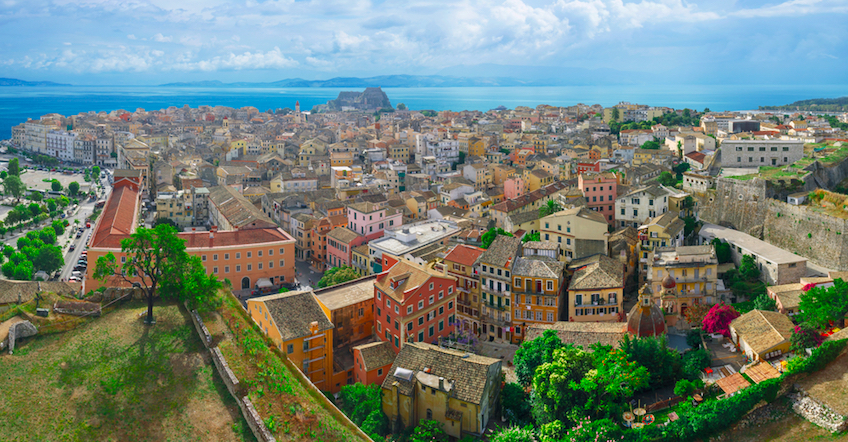
|
|
Kérkyra, the capital of
Corfu, is one of the most interesting towns in
Greece due to the strong influence of the
Venetians who for four-plus centuries
controlled the island. So it strongly resembles
an Italian city – a more savoury version of
Naples comes to mind for some visitors. Like
the other Ionian islands (except for Lefkáda),
Corfu was never occupied by the Ottomans, which
gives it a very different character from the
rest of Greece. But Kérkyra Town has had other
inputs as well: from the British, the French,
and the Greeks and Romans whose ancient
buildings are still in evidence at several
archaeological sites and the excellent
archaeological museum. The compact, strollable
old quarter, a protected UNESCO heritage site,
nestles between the two Venetian fortresses;
its oldest district – the Campiello – is a
particular joy to wander aimlessly around.
Although the German bombardment of September
1943 caused heavy damage – including the
destruction of the sumptuous Belle Époque
theatre-cum-opera-house – and most of the low
Venetian walls or gates enveloping the town
centre (including the Pórta Reále) were
thoughtlessly pulled down by the Greeks late in
the 19th century, enough has survived to make a
pleasing, homogenous ensemble of monumental
architecture, narrow lanes (the so-called
kandoúnia) and quiet little squares with
fountains in the middle. The population of
Kérkyra Town is about 30,000, not counting a
large student population at the locally
headquartered University of the Ionian, which
makes it one of the more cosmopolitan island
capitals.
|
|
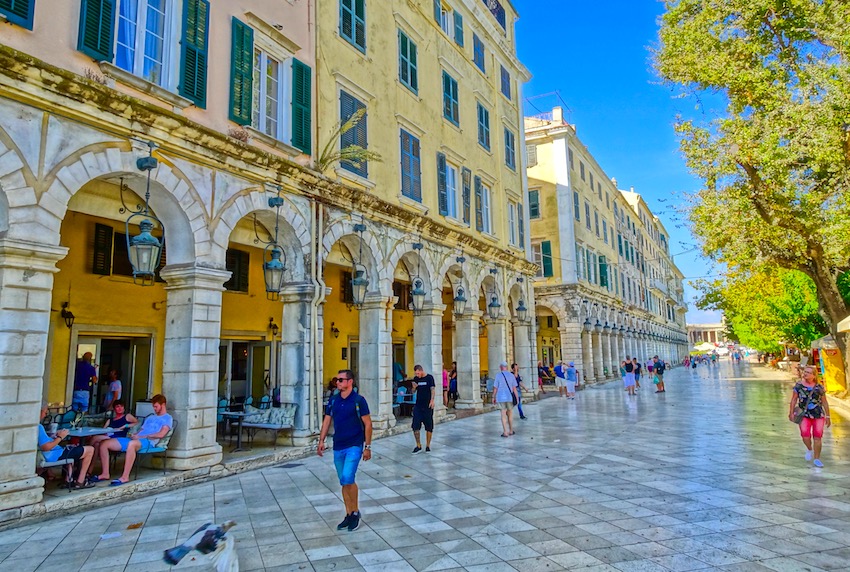
|
|
On the west side of
the Spianáda (Esplanade plaza),
Napoleonic-French style is most evident in the
Listón, an elegant arcaded
parade modelled on the Parisian Rue de Rivoli.
Under the arches shelter some of the most
popular (and expensive) cafés on the island;
the Olympia (aka Tou Zizimou)
is considered the most venerable and stylish.
Their tables overlook the Spianáda’s lawns,
which used to host weekend cricket matches (a
British introduction). Alas, parking demands
have shrunk the pitch here and most matches are
now held at a newish stadium out at Gouviá, but
you can still sit here and sip a ginger beer
(another British contribution). It was the
French who landscaped the
Spianáda, thus creating one of
the most attractive town squares in all of
Greece; for the Venetians it was merely a patch
of waste ground, the site of old houses
demolished to permit a free field of fire from
the Old Fort, which lies east of the Spianáda,
beyond the Contrafossa channel dug by the
Venetians and now home to a fishing
fleet.
|
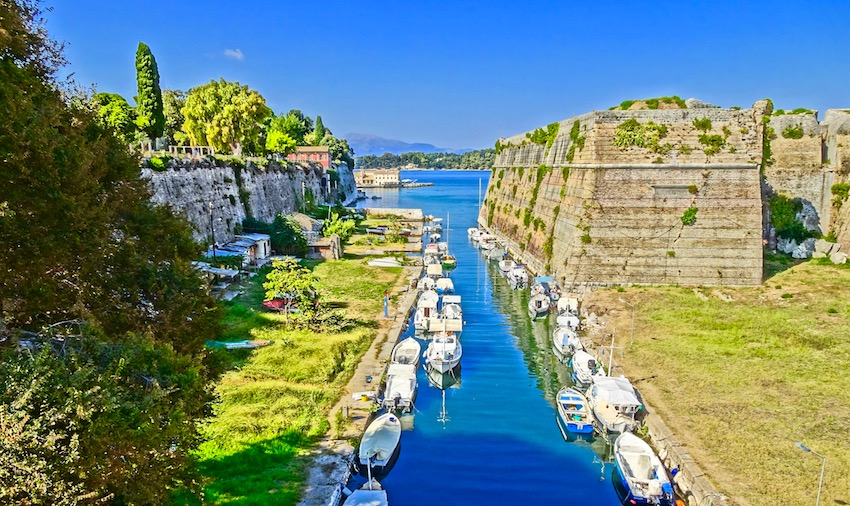
|
|
Although originally
established by the Byzantines during the 6th
century, most of the existing Old
Fort is of Venetian vintage; the
British demolished most of their additions
before handing the island over in 1864. Today
you enter at the Schulenberg statue via a metal
bridge, which replaced the old draw-bridge over
the Contrafossa; the adjacent gatehouse has
become an excellent small exhibit of Byzantine
and post-Byzantine mosaics and frescoes.
Further inside, there is the British-built
church of Saint George, a popular snack bar,
fortifications to climb around for excellent
views over town (best before noon), and on the
north flank of the fortifications a small
marina (with a restaurant) on the site of the
Venetian galley port.
|
|
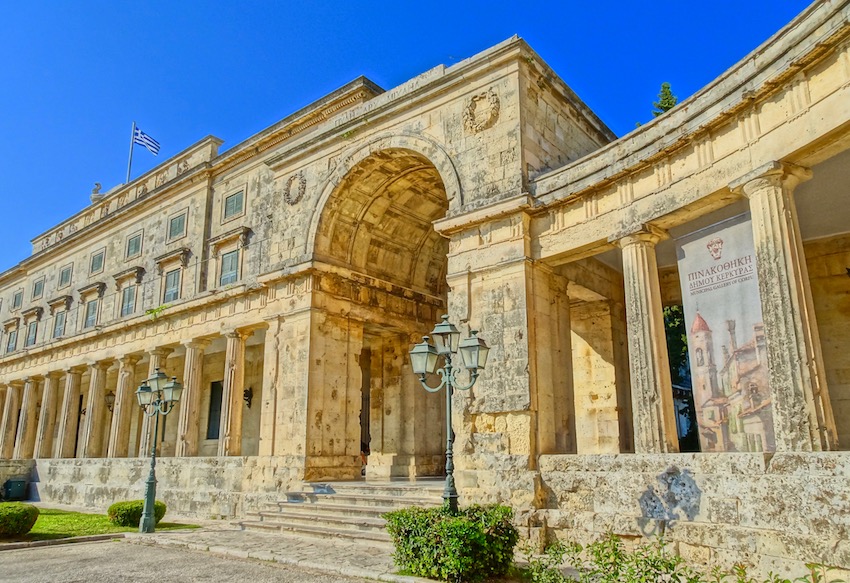
|
|
Bounding the
Spianáda on the north is the Palace of
Saint Michael and George, built
between 1819 and 1824 by Maltese stone masons
working for the British, and used as the
official residence of their high commissioner
and the seat of the rubber-stamp Ionian Senate.
Today it houses two museums, by far the more
interesting being the Museum of Asian
Art, containing almost 11,000 Asian
artefacts collected by two Greek diplomats with
exemplary taste stationed in the Far East. The
original, east wing comprises mostly funerary
statuary and bowls, pottery and blue-and-white
porcelain from various Chinese dynasties. The
newer, west wing houses an impressive
miscellany: Hindu and Jain deities, relief work
from Gandhara (a Hellenistic kingdom in
present-day Afghanistan), Buddhist devotional
art from every south Asian nation, Japanese
folding screens and woodblock prints by such
masters as Hokusai and Utamaro.
|
|
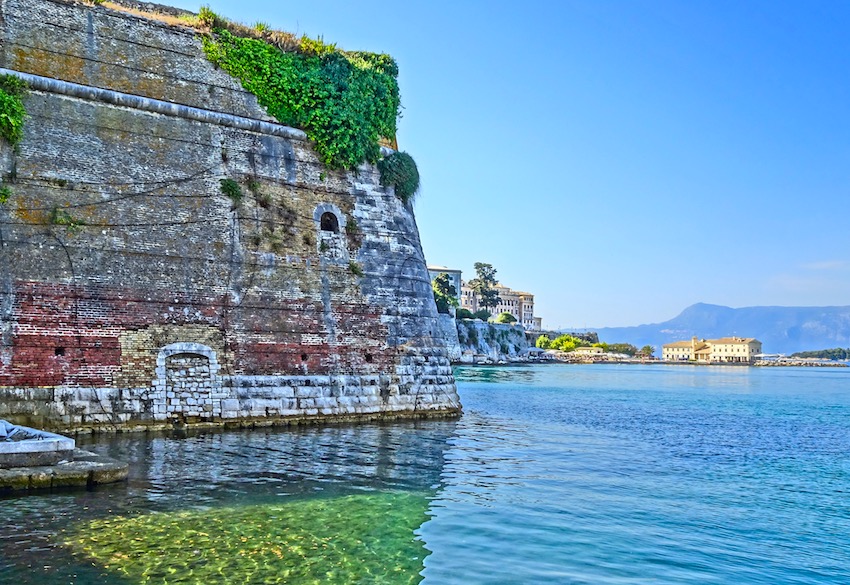
|
|
Behind the palace,
once past the little Faliráki
Lido with its summer snack-café,
chapel and pair of all-year bars, Arseníou
Street curls around the Campiello, allowing
fine sea views across to Albania and Vídos
islet, the final resting place for the most
desperately ill or wounded casualties among the
retreating Serbian army in 1916. From Arseníou,
a flight of steps climbs to the
Byzantine Museum housed in the
single-aisled, timber-roofed 15th-century
Andivouniótissa church. Once a private chapel
belonging to two notable families, it was
donated to the state in the 1970s, and now
contains a wealth of icons from the 15th to
19th centuries, many from the so-called Cretan
School; after Crete fell to the Ottomans, many
highly skilled artists came as refugees to
Venetian-held Corfu.
|
|
Nearby there is an
Orthodox cathedral, but the primary church in
the hearts of Corfiots is the one dedicated to
the island’s patron saint, Ágios
Spyrídon, just off the Listón,
containing Spyridon’s mummified body.
Originally a humble shepherd on Cyprus, he
became a monk, then a bishop, and took part in
the first Ecumenical Council of Nicea in 325AD.
After his death in 348 or 349, various miracles
were attributed to him, and his exhumed remains
were found to exude a pleasant odour – a sure
sign of sanctity. They were taken to
Constantinople for veneration in the church of
the Holy Apostles; when the city fell to the
Ottomans in 1453, his relics (along with those
of Saint Theodora Augusta) were sent to Corfu,
where they arrived after three years of
adventures. It is claimed that Saint Spyridon
has spared Corfu calamity on four occasions:
twice from epidemics, once from starvation, and
– at the height of the 1716 Turkish siege, on
11 August – by appearing above the defending
forces with a lighted torch and scaring the
invaders away.
|
|
That day is now a
local feast day of the saint, when his relics
are paraded through the streets, as they are on
Palm Sunday, Easter Saturday and the first
Sunday in November. The soundtrack for the
procession is always provided by one of Kérkyra
Town’s famous philharmonic
societies – rather confusingly, in
Greek filarmonikí means a municipal
marching band and not a symphonic orchestra as
in the Anglo-Saxon world. There are two – or
perhaps even three – competing, smartly
uniformed bands in the town, and very good they
are. (Corfu has a rich musical tradition, and
historically many of Athens’ symphony orchestra
players were initially trained in the island’s
conservatories). On Spyridon’s canonical feast
day (December 12) there’s no musical
procession, but his church stays open for 24
consecutive hours from the night before for
pilgrims to pay their respects. A goodly
fraction of the island’s men are named Spyros
(short for Spyridon).
|
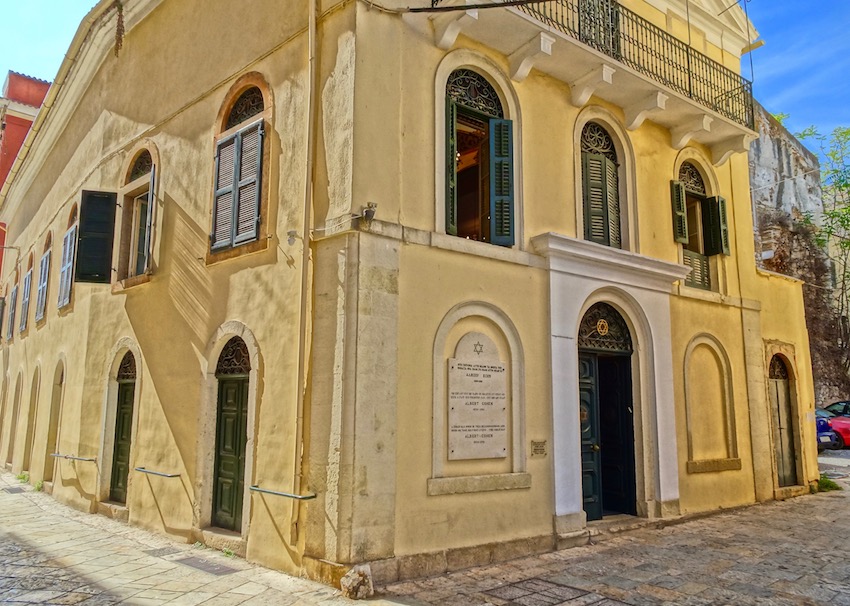
|
|
Other traces of
Kérkyra Town’s heterogenous religious past can
be found in the Catholic Cathedral of
SS James and Christopher on the
stepped Platía Dimarhíou, still open daily for
use by the over 3,000 local Catholics, all
descended from the Maltese masons brought here
by the British, and the sole surviving
synagogue at Velisaríou 4, the Scuola
Greca; just 60 Jews still live here,
too few to support a permanent rabbi who is
brought specially from Israel for the Rosh
Hashanah and Yom Kippur holidays.
|
|
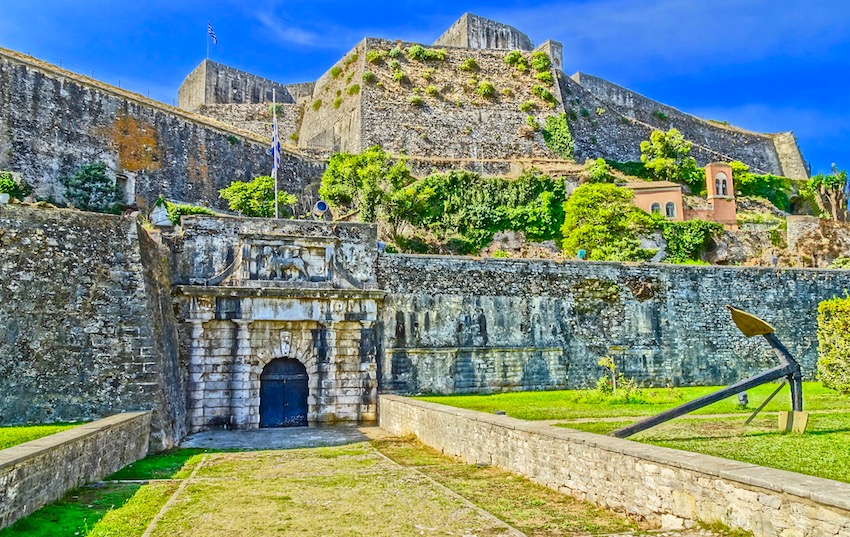
|
|
Above the old Jewish
quarter and the Spiliá neighbourhood abutting
the old port looms the New
Fort , built between 1572 and 1645 in
anticipation of the next, inevitable Ottoman
siege. It’s a masterpiece of military
architecture, with some later French and
British modifications, but the main reason to
show up today (in the afternoon) is for superb
views over the old-town rooftops, or if there’s
a special event inside.
|
|
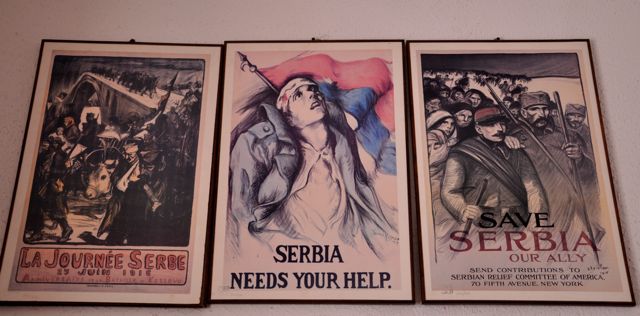 Above Platía Dimarhíou, at Moustoxýdou
19, one of the many parallel lanes of Pórta
Remoúnda district, is the Museum of the
Serbs on Corfu, which minutely
documents the experiences of the Serbian army
and government-in-exile here, when nearly
140,000 soldiers took shelter on Corfu from
January 1916 onwards: a little-known episode of
World War I. Amongst their other notional
allies, only France provided transport,
supplies and medical attention to the defeated
army – though a period poster, issued by a New
York-based relief committee, makes interesting
reading (“Save Serbia, Our Ally”) in light of
the American 1990s demonization of the
country. Above Platía Dimarhíou, at Moustoxýdou
19, one of the many parallel lanes of Pórta
Remoúnda district, is the Museum of the
Serbs on Corfu, which minutely
documents the experiences of the Serbian army
and government-in-exile here, when nearly
140,000 soldiers took shelter on Corfu from
January 1916 onwards: a little-known episode of
World War I. Amongst their other notional
allies, only France provided transport,
supplies and medical attention to the defeated
army – though a period poster, issued by a New
York-based relief committee, makes interesting
reading (“Save Serbia, Our Ally”) in light of
the American 1990s demonization of the
country.
The only significant
sight or site in the sprawling newer quarters
is the Archaeological Museum,
a short walking distance south of the Serb
museum at Vraïla 5. The most celebrated
attraction is the menacing Gorgon pediment (c.
585 BC) from the Temple of Artemis, discovered
in 1912 at Paleópolis, but rather unfairly it
tends to eclipse equally noteworthy finds such
as the earlier Archaic Lion of Menekrates, a
small pediment from 500 BC showing the god
Dionysos and a youth reclining at a symposium,
and a dozen statuettes of the goddess Artemis
in her primary aspect as mistress of the
beasts.
|
|
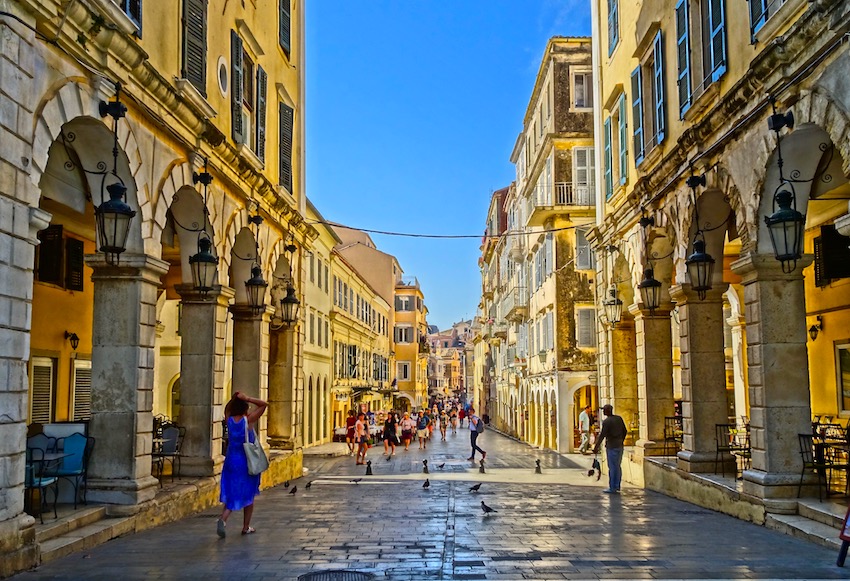
|
|
TOWN PRACTICALITIES
Kérkyra Town is ideal for
walking around, and you shouldn’t have to use
the urban blue-bus system with its base at
Platía Sarókko (San Rocco). The extravagant can
rent a horse-drawn carriage for a perimetric
tour of the town, or take the little train that
rides through the old city. The town is the
transportation hub for the island and you can
get anywhere by green bus (the station is in
the moat behind the New Fort), taxi or
by renting a car. Like any city you can find whatever
you need. There are supermarkets, outdoor
markets, clothing stores, gift shops, and
anything a local or tourist would need to
survive. And the city is a joy to
explore.
|
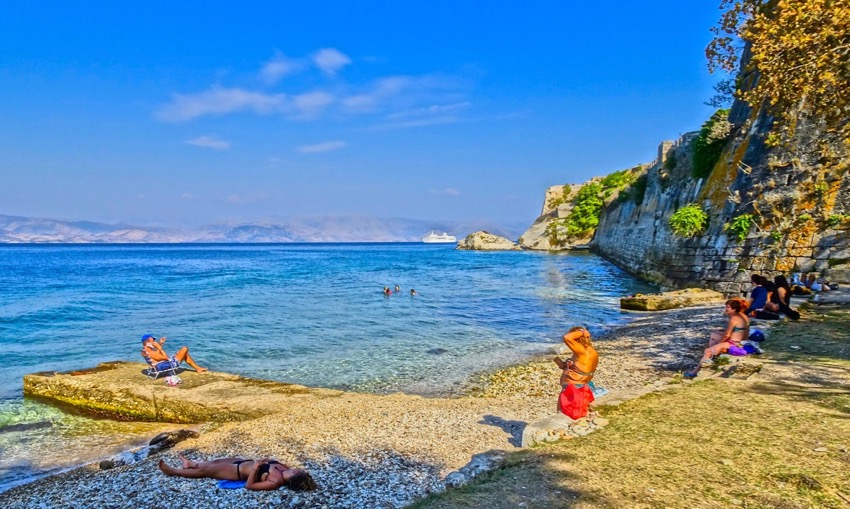
|
|
Though the best beaches
are outside of town, locals and tourists do
swim below the walls of the Old Fortress on the
north side of the peninsula. You have to go
into the fortress and go around to the left
side and it is near the sailboat marina. There
are also swimming areas by the Faliraki Lido
which is right behind the Palace of Saint
Michael and George.
|
|
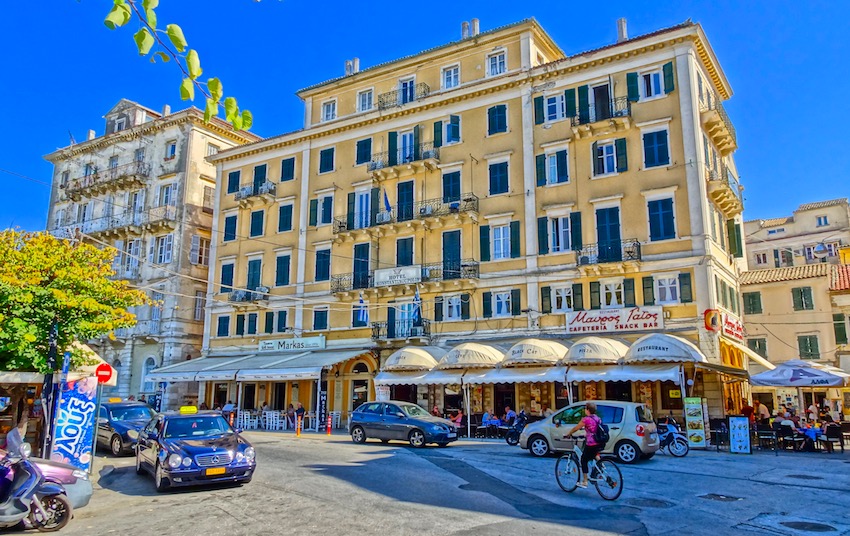
|
|
Where to Stay in Corfu
Town
There are several hotels
in the historic center of Corfu town for those
who want to stay here to take advantage of
excellent town dining and shopping
opportunities, venturing out to remote beaches
and villages by day by rental car or publictransportation. Overlooking Spianada Square
and the arcades of Liston, the charming
Arkadian
Hotel features
comfortable accommodations with free wireless
internet access in the heart of Corfu Town.
Each of Arcadion's spacious rooms is furnishedwith handmade furnishings and rich fabrics. The Siora
Vittoria Boutique Hotel is a 19th-century mansion with a
peaceful garden setting and charming, restored
accommodations with breakfast included. The
rooms are simply furnished with classic wooden
furniture, oak wood floors and marblebathrooms. The Nostalgia Corfu Town Luxury Apartments are 7 recently renovated, modern, airy and spacious holiday apartments conveniently situated close to Corfu Town and Corfu International Airport. Immaculate clean, bright, and different in sizes, these holiday apartments provide you with the ideal escape environment for any type of traveler that wants to enjoy the historic and cultured center of Corfu Town with family, friends, their loved one or solo while being close to restaurants, cafes, museums, beaches and all sights that Corfu town can offer to travelers.
For more hotels in Corfu contact Dolphin Hellas, Fantasy Travel or Aegean Thesaurus Travel, who can book hotels,
coordinate ferries and are available to assist you if you have any problems.
|
|
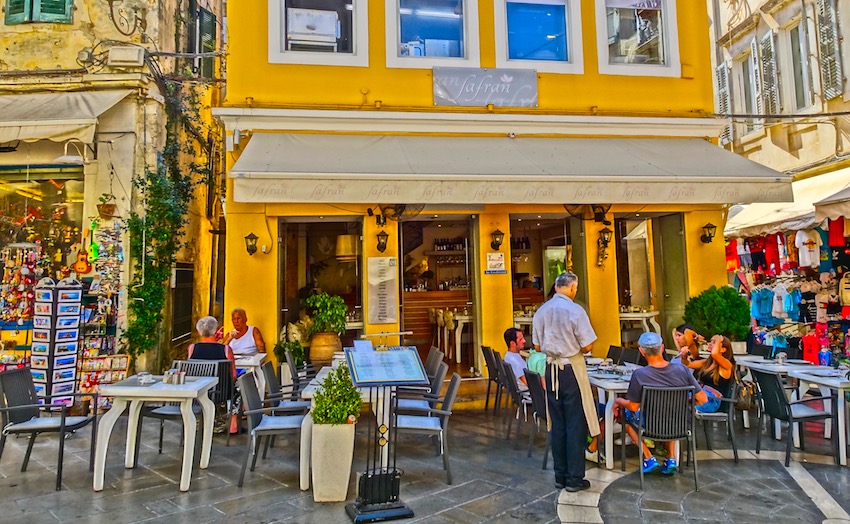
|
Corfu Restaurants
Corfu has a (deserved)
reputation as an expensive spot, but the
students and locals have to go out somewhere,
so a little digging around will uncover some
more-or-less normally priced options. Here's
some to start with...
Akamatra Zythopoleio
at Odos Prosaléndou 8–10,
Spiliá district. Atmospheric little canteen
preserving its original medieval arches and
pointed brick walls. It’s cheaper at lunchtime,
with hearty specials like bean soup, canneloni
and giouvarláki (rissole soup). The
proprietress would like to ditch the first part
of the name that she inherited – a November 17
hangout-village on Ikaría – but Greek
bureaucracy being what it is, she can’t without
significant bother. As the second tag
zythopolío indicates, they’re big on beer, both
imported and the local, somewhat pricey, red
beer and ale brewed at Corfu’s own microbrewery
in Arílas. Tel: 26610 40101. Open
Mon–Sat.
La Famiglia
Maniarízi & Arlióti 16
(Kandoúni Bízi), alley between Filellínon and
Nikifórou Theotóki. Kérkyra Town has about a
half-dozen Italian eateries from pizzeria to
full-blown trattoria; this basement bistro,
owned by a Greco-Italian couple since 2001 I
think, is reckoned the best. It’s certainly
cozy and usually full, so reservations are a
good idea. Expect a menu of salads, pasta
dishes like linguini all cozze, a few
token Greek platters like leek pie, and Italian
desserts. Excellent bulk wine from the Neméa
region or Santoríni. Tel: 26610 30270. Open
dinner only Mon–Sat, open Sun in August, closed
Sun & Mon Nov–April.
Khryssomallis (alias
Babis) Nikifórou Theotóki 6. The sign out
front reads zythopsitopolío
(“beer-hall-grill”), but it’s actually about
the last surviving traditional oven-food place
in the old town: stews, hórta,
mousakás, stuffed cabbage leaves,
lentil soup and so forth, washed down by smooth
but potent red bulk wine. From the outside
tables on the street you can even see the
Listón. The Durrells ate here during their
1930s stay; the restaurant has supposedly been
around for two decades prior to that. Get there
in good time at lunch, before the fixed local
clientele descends. Tel: 26610 30342. Open
daily until late.
Mouragia Arseníou 15, Mourágia quay. Competent
seaside ouzerí (though views to the water, and
Vídos islet, are from the inland side of the
street). A good mix of seafood such as
flash-fried atherína (sand smelt) and
Corfiot specialities like sofríto and
pastitsáda, plus competent starters;
maybe not as toothsome or copious in the
portion as when I first started eating here in
2002, but still good value for the location .
Tel: 26610 33815. Open Apr–Nov only (weather
does not permit otherwise) .
Rex Kapodistríou 66, behind the Listón.
If your wallet’s flush and your wardrobe’s
flash, this is the place for a special-occasion
blowout (count on 45 euros minimum per head).
One of the older (founded 1932) spots in town,
the Rex does generic Mediterranean
recipes with a nice nouvelle twist; on a winter
visit I had fish soup, orange-fleshed squash
turnover, portobello mushrooms with cheese. In
summer, there are less formal tables outside.
Tel: 26610 39649. Open
daily.
Rouvas Stamatíou Desýlla 13, Pórto Reále
bazaar. A classic lunchtime magerío
(canteen, cookshop) which despite a decidedly
unglamourous location attracts visiting
celebrity chefs like Rick Stein to learn just
how traditional island cooking should be (a tad
on the oily side, be warned). Recipes include
pastítsio, artichokes with peas, meat
stews, fish soup and hearty salads. Unlike many
casserole-dish places, the interior is bright
and appealing, rather than dingy. Tel: 26610
31182. Mon–Sat 9am–6pm.
Tsipouradiko
Prosaléndou 8–10, behind
the Efetío (Appeals Court), Spiliá. This is
the budget/bohemian/student hangout
for the town, thanks to a reliable buzz and
toleration of smokers (upstairs in the winter,
out in the courtyard in summer). Groups need to
book a table, or be prepared to wait a while.
Strong tsípouro (or quaffable bulk
wine) here complements grilled mushrooms,
courgette pie, tiganiá (pork
stir-fry), little fishes, and eggplant recipes.
Tel: 26610 82240. Open Mon–Sat dinner
only.
From Corfu Tour Guide Katerina Koulouridi: I would add as well “Ta Kokoria”, next to Saint Spyridon church, traditional taverna and huge portions! Then “Ninos”, for the best pita gyros in town and mageirio. Last but not least, Papagiorgis for the best gelato since 1924.
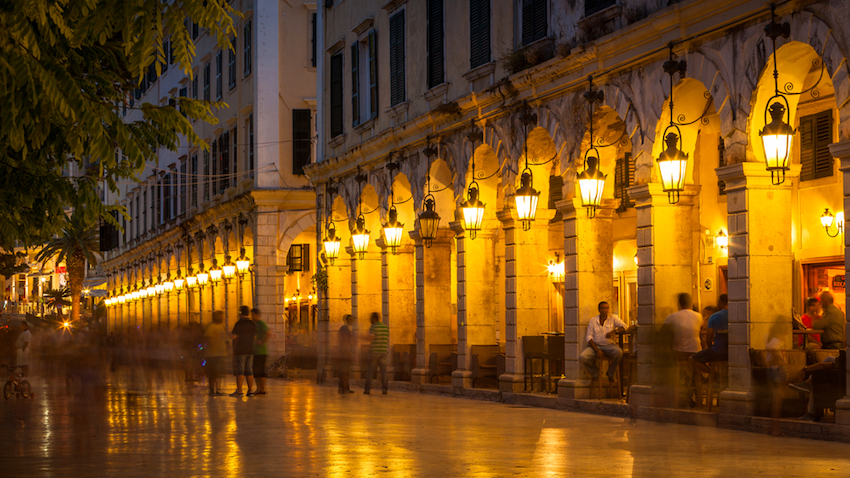
Nightlife
As everywhere in
Greece, the financial crisis has devastated
nightlife venues; forget
anything you may have read elsewhere about the
“Disco Strip” just west of the New Port – it is
essentially extinct. Of late, Corfiots and
visitors get their nocturnal kicks in more
low-key, inexpensive ways, for example at the
tiny Café del Arte
at Kandoúni Bízi 23 (with
acoustic music Thurs–Sat), the
Stablus multi-venue complex on Solomoú just
below the Spiliá gate of the New Fort (watch
for publicity posters on walls), and the
evergreen Café Bristol
just off Platía Vrahlióti,near the Listón. Newer venues include 54 Dreamy Nights, Elite, and Why Cocktail Bar (all close to the port). All visiting name Greek performers schedule their dates out at the
superbly intimate venue
Seven Arts Centre/Kendro Epta
Tekhnon out beyond the airport in Víros
village; they’ve no website, just check utility
poles/walls for posters advertising
events.
Marc
Dubin first visited Greece in 1978,
fell in love with it, and returned almost
yearly until he began living much of the time
on Samos in 1989. He has written for numerous
travel publishers – notably Rough Guides and
Insight Guides – and on a variety of topics
ranging from renovating old Greek houses and
Greek cuisine to back-country trekking and
Greek music. Marc has also compiled two CDs for
World Music Network, Rough Guide to Rebetika
and Rough Guide to Greek Café. He is an
accomplished photographer and most of the
pictures accompanying the articles on
greecetravel.com are his. (You can click on his
photos above to see them full size.) To contact
Marc with offers of writing jobs or praise you
can e-mail him through
matt@greecetravel.com
See Matt's 2018 Corfu Town
Photos
See Katerina's Corfu Tours
|
|








 Above Platía Dimarhíou, at Moustoxýdou
19, one of the many parallel lanes of Pórta
Remoúnda district, is the Museum of the
Serbs on Corfu, which minutely
documents the experiences of the Serbian army
and government-in-exile here, when nearly
140,000 soldiers took shelter on Corfu from
January 1916 onwards: a little-known episode of
World War I. Amongst their other notional
allies, only France provided transport,
supplies and medical attention to the defeated
army – though a period poster, issued by a New
York-based relief committee, makes interesting
reading (“Save Serbia, Our Ally”) in light of
the American 1990s demonization of the
country.
Above Platía Dimarhíou, at Moustoxýdou
19, one of the many parallel lanes of Pórta
Remoúnda district, is the Museum of the
Serbs on Corfu, which minutely
documents the experiences of the Serbian army
and government-in-exile here, when nearly
140,000 soldiers took shelter on Corfu from
January 1916 onwards: a little-known episode of
World War I. Amongst their other notional
allies, only France provided transport,
supplies and medical attention to the defeated
army – though a period poster, issued by a New
York-based relief committee, makes interesting
reading (“Save Serbia, Our Ally”) in light of
the American 1990s demonization of the
country.





